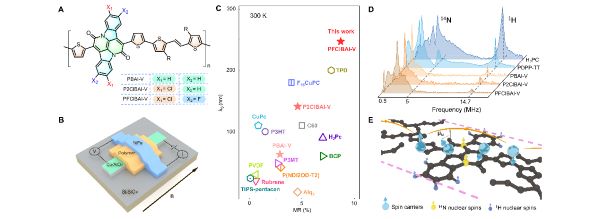Researchers Develop Edge Halogenation Strategy to Construct Efficient Spin-transport Organic Semiconductors
Prof. LIU Yunqi and Prof. GUO Yunlong from the Institute of Chemistry, Chinese Academy of Sciences, along with Prof. SUN Xiangnan and Prof. GUO Lidan from the National Center for Nanoscience and Technology, reported an edge halogenation strategy to enhance the spin transport properties of organic semiconductors.
Organic semiconductors, made of light elements, typically exhibit weak spin-orbit coupling, which allows for relatively long spin lifetimes and significant spin transport potential at room temperature. However, despite extensive research over the past two decades, spin transport efficiency in organic semiconductors remains low, showing magnetoresistance ratios below 5% and spin diffusion lengths under 100 nm.
This study highlights that focusing solely on hydrogen atoms is inadequate for understanding the complexities of organic optoelectronic materials. The researchers aimed to clarify the influence of molecular structure and spin relaxation on spin transport at room temperature.
For the first time, the study reveals the critical role of nitrogen atoms in molecular spin relaxation at room temperature, elucidating the coupling mechanism between electron spin and molecular structure. By introducing halogen substitutions at the edges of bay-annulated indigo units, the team achieved a tenfold increase in carrier mobility without compromising spin lifetime. This led to a spin diffusion length of 247 nm and a magnetoresistance ratio of 8.7% at room temperature. Additionally, hyperfine coupling of nitrogen atoms to electron spins produced coherent spin signals.
The findings indicate that nitrogen atoms provide stronger spin coupling than hydrogen under these conditions, a conclusion validated across various photoelectric functional molecules. This edge substitution strategy offers a novel approach for designing organic spin-transport materials.
The study published in Nature communications and supported by the National Natural Science Foundation of China, the Chinese Academy of Sciences and Ministry of Science and Technology of PRC.

Room-temperature spin transport and relaxation mechanism in bay-annulated indigo polymers (Image by YANG Xueli)
Contact:
Prof. GUO Yunlong
Institute of Chemistry, Chinese Academy of Sciences
Email: guoyunlong@iccas.ac.cn





